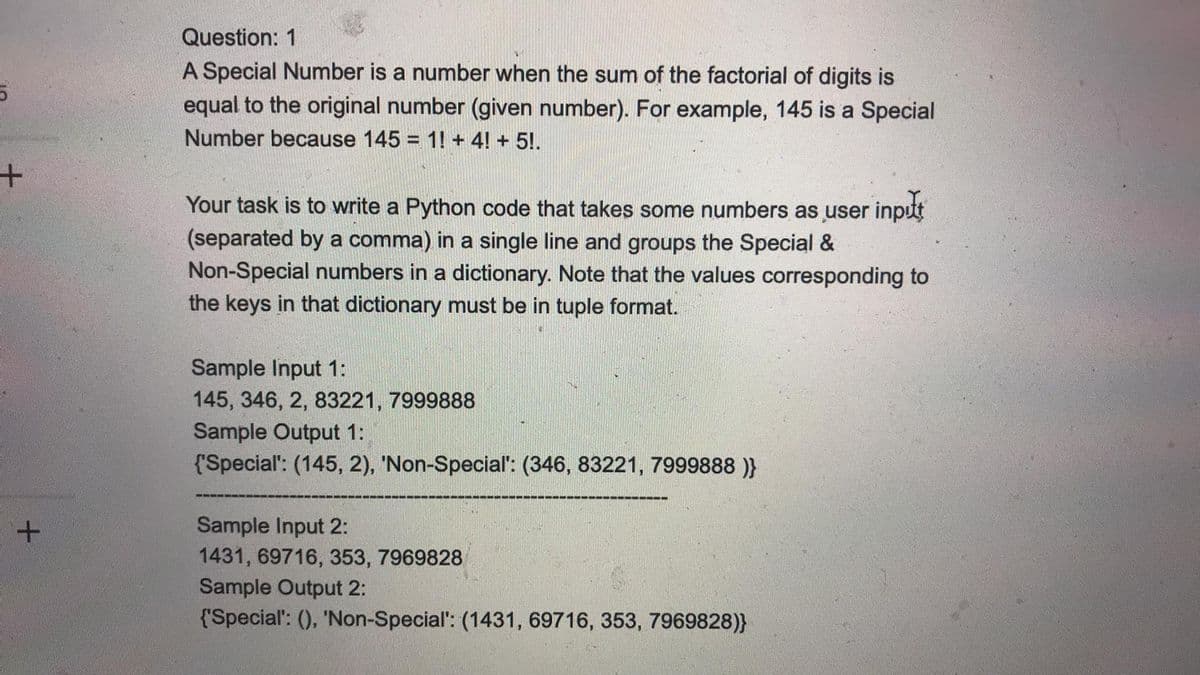Question: 1 A Special Number is a number when the sum of the factorial of digits is equal to the original number (given number). For example, 145 is a Special Number because 145 = 1! + 4! + 5!. Your task is to write a Python code that takes some numbers as user inpitt (separated by a comma) in a single line and groups the Special & Non-Special numbers in a dictionary. Note that the values corresponding to the keys in that dictionary must be in tuple format. Sample Input 1: 145, 346, 2, 83221, 7999888 Sample Output 1: {'Special': (145, 2), 'Non-Special': (346, 83221, 7999888 )} Sample Input 2: 1431, 69716, 353, 7969828 Sample Output 2: {'Special': (), 'Non-Special': (1431, 69716, 353, 7969828)}
Question: 1 A Special Number is a number when the sum of the factorial of digits is equal to the original number (given number). For example, 145 is a Special Number because 145 = 1! + 4! + 5!. Your task is to write a Python code that takes some numbers as user inpitt (separated by a comma) in a single line and groups the Special & Non-Special numbers in a dictionary. Note that the values corresponding to the keys in that dictionary must be in tuple format. Sample Input 1: 145, 346, 2, 83221, 7999888 Sample Output 1: {'Special': (145, 2), 'Non-Special': (346, 83221, 7999888 )} Sample Input 2: 1431, 69716, 353, 7969828 Sample Output 2: {'Special': (), 'Non-Special': (1431, 69716, 353, 7969828)}
Computer Networking: A Top-Down Approach (7th Edition)
7th Edition
ISBN:9780133594140
Author:James Kurose, Keith Ross
Publisher:James Kurose, Keith Ross
Chapter1: Computer Networks And The Internet
Section: Chapter Questions
Problem R1RQ: What is the difference between a host and an end system? List several different types of end...
Related questions
Question

Transcribed Image Text:Question: 1
A Special Number is a number when the sum of the factorial of digits is
equal to the original number (given number). For example, 145 is a Special
Number because 145 = 1! + 4! + 5!.
Your task is to write a Python code that takes some numbers as user inpt
(separated by a comma) in a single line and groups the Special &
Non-Special numbers in a dictionary. Note that the values corresponding to
the keys in that dictionary must be in tuple format.
Sample Input 1:
145, 346, 2, 83221, 7999888
Sample Output 1:
{'Special: (145, 2), 'Non-Special': (346, 83221, 7999888 )}
Sample Input 2:
1431, 69716, 353, 7969828
Sample Output 2:
+.
{'Special': (), 'Non-Special': (1431, 69716, 353, 7969828)}
Expert Solution
This question has been solved!
Explore an expertly crafted, step-by-step solution for a thorough understanding of key concepts.
Step by step
Solved in 2 steps with 1 images

Recommended textbooks for you

Computer Networking: A Top-Down Approach (7th Edi…
Computer Engineering
ISBN:
9780133594140
Author:
James Kurose, Keith Ross
Publisher:
PEARSON

Computer Organization and Design MIPS Edition, Fi…
Computer Engineering
ISBN:
9780124077263
Author:
David A. Patterson, John L. Hennessy
Publisher:
Elsevier Science

Network+ Guide to Networks (MindTap Course List)
Computer Engineering
ISBN:
9781337569330
Author:
Jill West, Tamara Dean, Jean Andrews
Publisher:
Cengage Learning

Computer Networking: A Top-Down Approach (7th Edi…
Computer Engineering
ISBN:
9780133594140
Author:
James Kurose, Keith Ross
Publisher:
PEARSON

Computer Organization and Design MIPS Edition, Fi…
Computer Engineering
ISBN:
9780124077263
Author:
David A. Patterson, John L. Hennessy
Publisher:
Elsevier Science

Network+ Guide to Networks (MindTap Course List)
Computer Engineering
ISBN:
9781337569330
Author:
Jill West, Tamara Dean, Jean Andrews
Publisher:
Cengage Learning

Concepts of Database Management
Computer Engineering
ISBN:
9781337093422
Author:
Joy L. Starks, Philip J. Pratt, Mary Z. Last
Publisher:
Cengage Learning

Prelude to Programming
Computer Engineering
ISBN:
9780133750423
Author:
VENIT, Stewart
Publisher:
Pearson Education

Sc Business Data Communications and Networking, T…
Computer Engineering
ISBN:
9781119368830
Author:
FITZGERALD
Publisher:
WILEY